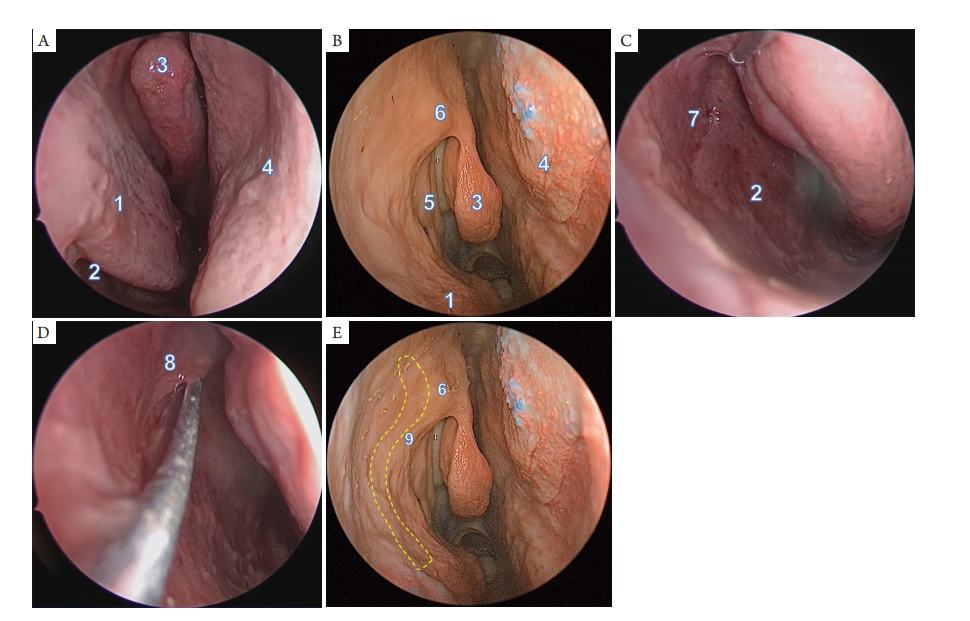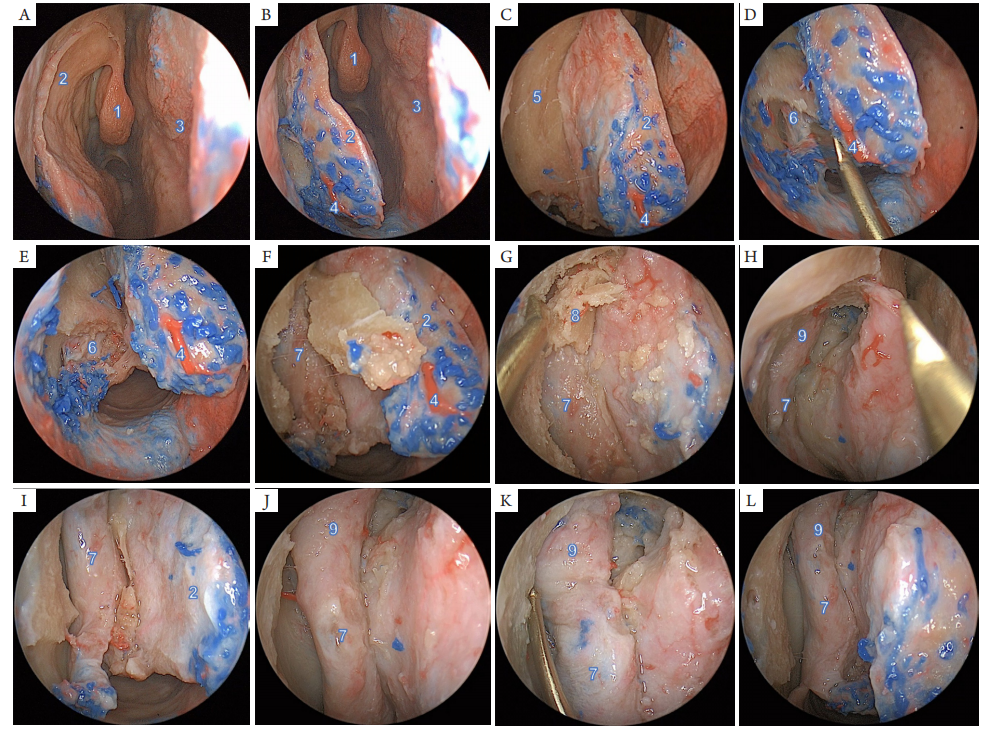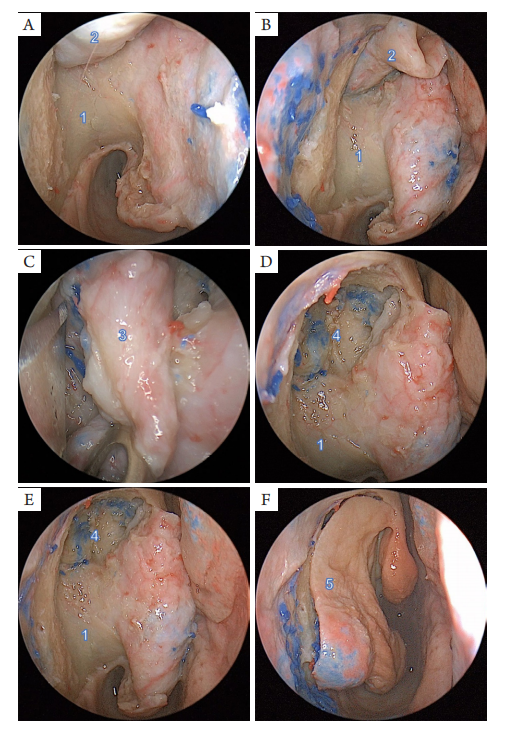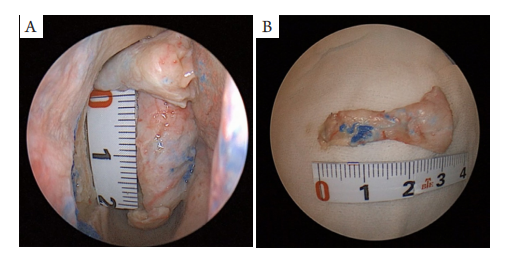1、Rajak SN, Psaltis AJ. Anatomical considerations in endoscopic lacrimal surgery[ J]. Ann Anat, 2019, 224: 28-32.Rajak SN, Psaltis AJ. Anatomical considerations in endoscopic lacrimal surgery[ J]. Ann Anat, 2019, 224: 28-32.
2、中华医学会眼科学分会眼整形眼眶病学组. 中国内镜泪囊鼻腔吻合术治疗慢性泪囊炎专家共识(2020年)[ J]. 中华眼科杂志,2020, 56(11): 820-823.
Ophthalmology Orbital Disease Group of Chinese Medical Association Ophthalmology Branch. Expert consensus on the treatment of chronic dacryocystitis with endoscopic dacryocystorhinostomy in China[ J]. Chinese Journal of Ophthalmology, 2020, 56(11): 820-823.中华医学会眼科学分会眼整形眼眶病学组. 中国内镜泪囊鼻腔吻合术治疗慢性泪囊炎专家共识(2020年)[ J]. 中华眼科杂志,2020, 56(11): 820-823.
Ophthalmology Orbital Disease Group of Chinese Medical Association Ophthalmology Branch. Expert consensus on the treatment of chronic dacryocystitis with endoscopic dacryocystorhinostomy in China[ J]. Chinese Journal of Ophthalmology, 2020, 56(11): 820-823.
3、Villaret AB, Lombardi D, Schreiber A, et al. Oncocytic carcinoma of the nasolacrimal duct treated by transnasal endoscopic resection[ J]. Head Neck, 2013, 35(1): E24-E27.Villaret AB, Lombardi D, Schreiber A, et al. Oncocytic carcinoma of the nasolacrimal duct treated by transnasal endoscopic resection[ J]. Head Neck, 2013, 35(1): E24-E27.
4、Curragh DS, James C, Selva D. Swinging inferior turbinate approach to the nasolacrimal duct[ J]. Orbit, 2020, 39(2): 112-117.Curragh DS, James C, Selva D. Swinging inferior turbinate approach to the nasolacrimal duct[ J]. Orbit, 2020, 39(2): 112-117.
5、Curragh DS, Psaltis AJ, Tan NC, et al. Prelacrimal approach for nasolacrimal duct excision in the management of lacrimal system tumours[ J]. Orbit, 2019, 38(4): 308-312.Curragh DS, Psaltis AJ, Tan NC, et al. Prelacrimal approach for nasolacrimal duct excision in the management of lacrimal system tumours[ J]. Orbit, 2019, 38(4): 308-312.
6、Rajesh Raju G, Sandeep S. Lacrimal Sac Rhinosporidiosis and surgical management by transnasal endoscopic excision: A case series[ J]. Laryngoscope, 2018, 128(12): 2693-2696.Rajesh Raju G, Sandeep S. Lacrimal Sac Rhinosporidiosis and surgical management by transnasal endoscopic excision: A case series[ J]. Laryngoscope, 2018, 128(12): 2693-2696.
7、Chang CH, Ku WN, Kung WH, et al. Navigation-assisted endoscopic surgery of lacrimal sac tumor[ J]. Taiwan J Ophthalmol, 2020, 10(2): 141-143.Chang CH, Ku WN, Kung WH, et al. Navigation-assisted endoscopic surgery of lacrimal sac tumor[ J]. Taiwan J Ophthalmol, 2020, 10(2): 141-143.
8、McDonogh M, Meiring JH. Endoscopic transnasal dacryocystorhinostomy[ J]. J Laryngol Otol, 1989, 103(6): 585-587.McDonogh M, Meiring JH. Endoscopic transnasal dacryocystorhinostomy[ J]. J Laryngol Otol, 1989, 103(6): 585-587.
9、Alam MS, Mukherjee B, Krishnakumar S. Clinical profile and management outcomes of lacrimal drainage system malignancies[ J]. Orbit, 2022, 41(4): 429-436.Alam MS, Mukherjee B, Krishnakumar S. Clinical profile and management outcomes of lacrimal drainage system malignancies[ J]. Orbit, 2022, 41(4): 429-436.
10、Krishna Y, Coupland SE. Lacrimal sac tumors—A review[ J]. Asia Pac J Ophthalmol (Phila), 2017, 6(2): 173-178.Krishna Y, Coupland SE. Lacrimal sac tumors—A review[ J]. Asia Pac J Ophthalmol (Phila), 2017, 6(2): 173-178.
11、Singh S, Ali MJ. Primary malignant epithelial tumors of the lacrimal drainage system: A major review[ J]. Orbit, 2021, 40(3): 179-192.Singh S, Ali MJ. Primary malignant epithelial tumors of the lacrimal drainage system: A major review[ J]. Orbit, 2021, 40(3): 179-192.
12、蒋永强, 王彬, 李晓华, 等. 泪囊原发性恶性肿瘤22例临床病理学分析[ J]. 中华眼外伤职业眼病杂志, 2019, 41(2): 81-84.
JIANG Yongqiang, WANG Bin, LI Xiaohua, et al. Clinicopathological analysis of 22 cases with primary malignant tumors of the lacrimal sac[ J]. Chinese Journal of Ocular Trauma and Occupational Eye Disease, 2019, 41(2): 81-84.蒋永强, 王彬, 李晓华, 等. 泪囊原发性恶性肿瘤22例临床病理学分析[ J]. 中华眼外伤职业眼病杂志, 2019, 41(2): 81-84.
JIANG Yongqiang, WANG Bin, LI Xiaohua, et al. Clinicopathological analysis of 22 cases with primary malignant tumors of the lacrimal sac[ J]. Chinese Journal of Ocular Trauma and Occupational Eye Disease, 2019, 41(2): 81-84.
13、赵云, 惠靖雯, 杨丽红, 等. 原发性泪道肿物64例临床组织病理学分析. 中华眼科杂志, 2020, (05): 364-369.
ZHAO Yun, HUI Jingwen, YANG Lihong , et al. Clinical and pathological analysis of 64 patients with primary neoplasms of the lacrimal drainage system[ J]. Chinese Journal of Ophthalmology, 2020, 56(5): 364-369.赵云, 惠靖雯, 杨丽红, 等. 原发性泪道肿物64例临床组织病理学分析. 中华眼科杂志, 2020, (05): 364-369.
ZHAO Yun, HUI Jingwen, YANG Lihong , et al. Clinical and pathological analysis of 64 patients with primary neoplasms of the lacrimal drainage system[ J]. Chinese Journal of Ophthalmology, 2020, 56(5): 364-369.
14、Heindl LM, Jünemann AG, Kruse FE, et al. Tumors of the lacrimal drainage system[ J]. Orbit, 2010, 29(5): 298-306.Heindl LM, Jünemann AG, Kruse FE, et al. Tumors of the lacrimal drainage system[ J]. Orbit, 2010, 29(5): 298-306.
15、Reshef ER , Bleier BS, Freitag SK . The endoscopic transnasal approach to orbital tumors: A review[ J]. Semin Ophthalmol, 2021, 36(4): 232-240.Reshef ER , Bleier BS, Freitag SK . The endoscopic transnasal approach to orbital tumors: A review[ J]. Semin Ophthalmol, 2021, 36(4): 232-240.
16、Ramberg I, Toft PB, Heegaard S. Carcinomas of the lacrimal drainage system[ J]. Surv Ophthalmol, 2020, 65(6): 691-707.Ramberg I, Toft PB, Heegaard S. Carcinomas of the lacrimal drainage system[ J]. Surv Ophthalmol, 2020, 65(6): 691-707.
17、Parmar DN, Rose GE. Management of lacrimal sac tumours[ J]. Eye (Lond), 2003, 17(5): 599-606.Parmar DN, Rose GE. Management of lacrimal sac tumours[ J]. Eye (Lond), 2003, 17(5): 599-606.
18、El-Sawy T, Frank SJ, Hanna E, et al. Multidisciplinary management of lacrimal sac/nasolacrimal duct carcinomas[ J]. Ophthalmic Plast Reconstr Surg, 2013, 29(6): 454-457.El-Sawy T, Frank SJ, Hanna E, et al. Multidisciplinary management of lacrimal sac/nasolacrimal duct carcinomas[ J]. Ophthalmic Plast Reconstr Surg, 2013, 29(6): 454-457.
19、Rebeiz EE, Shapshay SM, Bowlds JH, et al. Anatomic guidelines for dacryocystorhinostomy[ J]. Laryngoscope, 1992, 102(10): 1181-1184.Rebeiz EE, Shapshay SM, Bowlds JH, et al. Anatomic guidelines for dacryocystorhinostomy[ J]. Laryngoscope, 1992, 102(10): 1181-1184.
20、Wormald PJ, Kew J, Van Hasselt A. Intranasal anatomy of the nasolacrimal sac in endoscopic dacryocystorhinostomy[ J]. Otolaryngol Head Neck Surg, 2000, 123(3): 307-310.Wormald PJ, Kew J, Van Hasselt A. Intranasal anatomy of the nasolacrimal sac in endoscopic dacryocystorhinostomy[ J]. Otolaryngol Head Neck Surg, 2000, 123(3): 307-310.
21、张速勤, 贾沛靓, 唐海红, 等. 泪囊鼻内解剖研究及临床应用. 中华耳鼻咽喉头颈外科杂志, 2006, 41(7): 506-509.
ZHANG Suqin, JIA Peiliang, TANG Haihong, et al. Endonasal anatomy of lacrimal sac and its clinical significance in dacryocystorhinostomy[ J]. Chinese Journal of Otorhinolaryngology Head and Neck Surgery, 2006, 41(7): 506-509.张速勤, 贾沛靓, 唐海红, 等. 泪囊鼻内解剖研究及临床应用. 中华耳鼻咽喉头颈外科杂志, 2006, 41(7): 506-509.
ZHANG Suqin, JIA Peiliang, TANG Haihong, et al. Endonasal anatomy of lacrimal sac and its clinical significance in dacryocystorhinostomy[ J]. Chinese Journal of Otorhinolaryngology Head and Neck Surgery, 2006, 41(7): 506-509.






